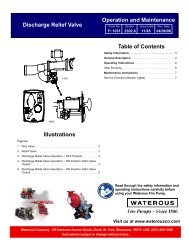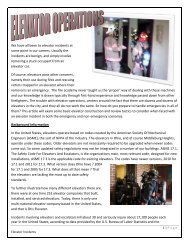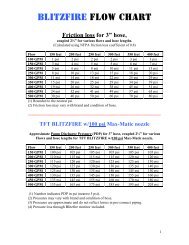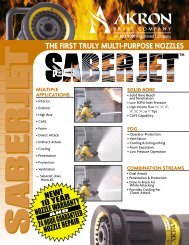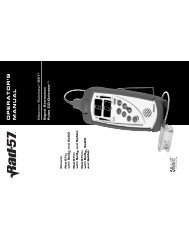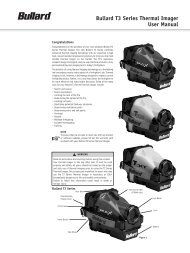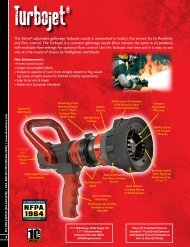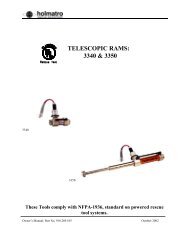MSA_Firehawk_M7_Mask.. - SOLD
MSA_Firehawk_M7_Mask.. - SOLD
MSA_Firehawk_M7_Mask.. - SOLD
- No tags were found...
You also want an ePaper? Increase the reach of your titles
YUMPU automatically turns print PDFs into web optimized ePapers that Google loves.
REMOVING THE AIR MASKto a brown or black color, decals charred or missing,gauge lens melted, or elastomeric materialsdistorted.2. Use this device only after receiving proper trainingin its use. Use in accordance with this label and<strong>MSA</strong> apparatus instructions.3. To maintain NIOSH approval, the cylinder must befully charged with respirable air meeting therequirements of the Compressed Gas Associationspecification G-7.1 1989 for Quality VerificationLevel (grade) D air or equivalent specification. Infire service applications, <strong>MSA</strong> recommends breathingair quality in accordance with NFPA 1989.4. Do not use unless the cylinder is filled to the maximumworking pressure.5. Do not alter, modify, or substitute any componentswithout approval of the manufacturer.6. Inspect frequently. Maintain according to manufacturer’sinstructions. Repair only by properly trainedpersonnel.Failure to follow these warnings can result in seriouspersonal injury or death.SAFETY PRECAUTIONS FOR <strong>MSA</strong> SELF-CONTAINEDBREATHING APPARATUS CYLINDERSBreathing apparatus cylinders should be fully rechargedas soon as possible after use.Cylinders should not be stored partially charged:1. If used partially charged, the duration of the air maskis reduced.2. The pressure relief device is only designed to protecta fully charged cylinder from the effects of a fire.For maximum safety, the cylinders should be stored full orat a pressure above ambient but less than 100 psi.Prior to recharging, cylinders must be examined externallyfor evidence of high heat exposure, corrosion, or otherevidence of significant damage.Additional information of value when performing externaland internal inspections of cylinders may be found in thelatest editions of CGA Publication C-6: "Standards forVisual Inspection of Steel Compressed Gas Cylinders",CGA Publication C-6.1: "Standards for Visual Inspectionof High Pressure Aluminum Compressed Gas Cylinders",and/or CGA Publication C-6.2: "Guidelines for VisualInspection and Requalification of Fiber Reinforced HighPressure Cylinders" available form the Compressed GasAssociation, Inc., 1725 Jefferson Davis Highway, Suite1004, Arlington, VA 22202-4102.If there is any doubt about the suitability of the cylinderfor recharge, it should be returned to a certified hydrostatictest facility for expert examination and testing.Always check to be sure the retest date is within the prescribedperiod and that the cylinder is properly labeled toindicate its gaseous service. New labels are restricteditems which are not available except through certifiedhydrostatic test facilities.When replacing cylinder valves or after the retesting ofcylinders, make sure the proper cylinder valve, burst disc,and o-ring are installed prior to cylinder recharging.Determine the maximum service pressure of the cylinder.Type 3 AA (steel) cylinders that bear a plus (+) sign afterthe latest retest date may be recharged to a pressure, i.e.a cylinder stamped 3AA2015 with a plus (+) sign after thetest date may be recharged to 2216 psi. (this applies tosteel cylinders only). Steel cylinders without the plus (+)sign stamped after the latest test date must be removedfrom service. All other cylinders which are not 3AA typeshall be filled to the designated service pressure only (asfound on the DOT approval or stamping). For cylindersmanufactured under a U.S. DOT exemption (i.e., DOT-E-#####), the exemption should be consulted and is availablefrom the Associate Administrator for HazardousMaterials Safety, Research and Special ProgramsAdministration, U.S. Department of Transportation, 4007th Street, SW, Washington, D.C. 20590-0001.Appropriately connect the cylinder to the filling systemand refill. Terminate the filling when the pressure reachesthe maximum service pressure and allow the cylinder tocool to room temperature. If necessary, top-off the cylindersuch that the service pressure is attained with thecylinder at a temperature of 70°F. Close the valves on thecylinder and the filling system and remove the cylinder.Apply a leak solution to determine if there is any leakagebetween the cylinder and the valve. If there is no leakage,the cylinder is ready for use.STORAGEDo not store the air mask or spare cylinders within or nearan area where the air mask can or might be exposed toany substances that will or might attack any part of the airmask, causing the air mask to not perform as designedand approved.Prior to storing the air mask in a jumpseat, ensure there isno interference between the air mask and the seat.DO NOT drop the cylinder or bump the valve knob. Anunsecured cylinder can become an airborne projectileunder its own pressure if the valve is opened evenslightly. Failure to follow this warning can result inserious personal injury or death.Do not store the air mask for extended periods with thebatteries installed in the electronic components if the air31 TAL 806 (L) Rev. 3 - 10082858



